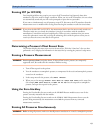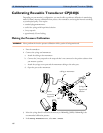
Editing the Wedge 12 Monitoring Invasive Pressure
159
not be displayed or recorded properly. To avoid this, switch out of optimum scale before
performing a wedge procedure.
3 Use the Reference Wave 1 and 2 popup keys to select any ECG or respiratory wave as
reference waves.
4 Select Wave Speed if you want to synchronize all displayed waves to your preferred speed.
5 Inflate the balloon when the monitor prompts you: Ready for balloon inflation. The
waveform changes from the PAP to the PAWP wave. The measurement takes approximately 12
seconds. On completion, the monitor stores the PAWP waveform display and prompts you to
deflate the balloon. If the monitor cannot detect a wedging waveform you must use
Store
Trace
to store the wedge and two reference waves manually.
6 Deflate the balloon when the monitor prompts you: Ready for balloon deflation and
verify that the waveform returns to pulmonary artery shape.
7 If you need to start a new measurement, select Restart Wedge.
Editing the Wedge
1 Select the Edit Wedge pop-up key to see the stored waveforms.
2 The monitor displays a cursor in the waveform at the PAWP mean value. It also displays any
previously stored value and the time it was stored.
3 Move the cursors up, down, right and left to set them on the correct wedge position.
4 Select Store Wedge to store the PAWP value.
5 Select Print Wedge to print the PAWP waveform and any reference waves or Record Wedge to
record them. While recording or printing, you cannot perform any more Wedge tasks.
WARNING Prolonged inflation can cause pulmonary hemorrhage, infarction or both. Inflate the balloon for the
minimum time necessary to get an accurate measurement.
If the pulmonary artery flotation catheter drifts into the wedge position without inflation of the balloon, the
pulmonary artery pressure waveform assumes a wedged appearance. Take appropriate action, in accordance
with standard procedures, to correct the situation.
If the PAWP (mean) is greater than the PAP (systolic), deflate the balloon and report the incident in
accordance with hospital policy, because the pulmonary artery could be accidently ruptured, and the wedge
value derived will not reflect the patient’s hemodynamic state, but will merely reflect the pressure in the
catheter or balloon.


















